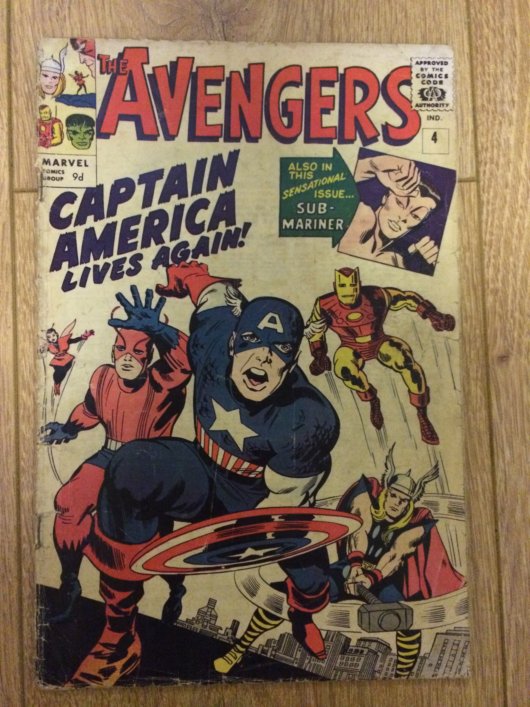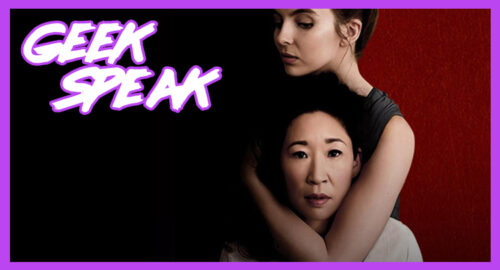Despite knowing since childhood that my dad owns every single issue of Marvel Comics series The Avengers, I think this is the first time I’ve ever seen his copy of issue #1 in the flesh. Here I am, holding a comic only three years younger than my dad and it feels so far removed from what The Avengers represents today.
I ask my dad, Derek, how he got into the series when he was a kid: “Like so many kids of my age, the Batman TV series which debuted here in the UK in late 1966 had a huge influence on me. Within a week or so shops were selling the original DC Batman comics and us British school-kids, brought up on a diet of black and white comics, couldn’t believe the all-colour comics from the States!
“I don’t know if it was all over the UK or whether we were just lucky in the part of suburban Kent I lived, but almost every newsagent around this time stocked an incredible array of these American comics and I lapped them up. Marvel quickly became my publisher of choice and as well as the superheroes (Spiderman, Daredevil, Hulk) there were cowboy and war titles. And visiting my grandparents in Streatham took us past Brixton Market where there were second hand Marvel comics to buy – what a treasure trove! In a short time I became a massive fan of the super-hero group that Marvel put together in 1963 and I started reading four years later, The Mighty Avengers!”
Flicking through the original issue, it’s clear there is very little in common between their comic and movie origins. There’s no Nick Fury, no mention of SHIELD and no Captain America. The assembled heroes weren’t even Marvel’s big guns but lesser heroes, none of which even had their own stand alone comic at the time. Instead they appeared in titles that reflected the pre-superhero era of comics, such as Tales to Astonish, Tales of Suspense and Journey into Mystery. Even The Hulk standalone comic had been cancelled after only six issues.
The only real link between the respective origins is what causes the formation of The Avengers – in both the movie and the comic. In Avengers #1 Loki manipulates the Hulk to make it appear that he is a threat to humanity. A group of teenagers attempt to contact the Fantastic Four for help and instead Loki diverts the signal to his nemesis, Thor, instead. However, this signal is picked up by Iron Man, Ant Man and The Wasp. Together they learn the truth of Thor’s evil half-brother’s machinations, and join together with the Hulk to defeat him. Impressed by how well their linking up had gone, they decide to form themselves into a group.
Perhaps the most defining event of The Avengers doesn’t occur until issue #4: the discovery of Captain America alive and encased in ice. I ask my dad how much this deviates from the movie version.
“Captain America was a legendary Marvel character even at this point – having featured in the company’s output of comics during the Second World War (Marvel was called Timely then but it was the same company). Incredibly Stan Lee was Captain America’s writer in those early 1940s war-time issues where the weedy Steve Rogers was transformed into America’s super-soldier and had his youthful partner Bucky Barnes. Or perhaps it wasn’t that incredible (though Lee was young then to be such a prominent comic book writer) for actually the gap from the mid ’40s to the star-spangled hero’s discovery floating in an iceberg by The Avengers was actually barely 20 years. The difference for a bewildered Steve Rogers emerging from what had seemed an icy tomb blinking into the 1960s world is, when you think about it, hugely different from the movie, where such incarceration had been for over 70 years! Captain America had started to reappear in newly written wartime based stories in Tales of Suspense – but Avengers #4 marked his return to the present day.”
Unlike its DC counterpart Justice League of America and Stan Lee’s early ’60s creation, Fantastic Four, The Avengers has always been characterised by its relatively fluid roster. As early as issue #16 almost the entire cast was replaced, with only Captain America remaining. The replacement heroes had been recently introduced to the Marvel Universe initially as villains. These were Hawkeye, and Avengers: Age of Ultron twins The Scarlet Witch and Quicksilver. Although The Avengers remained largely a collection of existing characters, Avengers #57 marked a significant departure and introduced one of the most famous faces in Marvel history, The Vision. My dad goes into further detail on The Vision’s origin:
“Probably my all-time favourite Avengers issues are from # 57 through to issue #100 where writer Roy Thomas and legendary artists John Buscema and then Barry Smith produced some dazzlingly beautiful stories – beginning with the birth (literally) of the android with a human consciousness, the Vision. This run saw original Avenger Hank Pym (who’d already used the names Ant Man, Giant Man and Goliath as a member of the group) adopt a briefly evil alter-ego of Yellowjacket and it gradually unravelled that in a confused state, Pym had inadvertently created an all-powerful robot who was to become the group’s greatest nemesis, Ultron. Ultron in turn had made sentient again the consciousness of Wonder Man (who’d briefly been a member of The Avengers back in issue #9) and this android, called The Vision, who was designed to betray the Avengers but ended up joining them, became so close to human he ended by having a love affair with The Scarlet Witch.
“Meanwhile the Wasp finally married Pym, Hawkeye relinquished his bow and arrow to assume the giant-sized mantle of the new Goliath and the series’ first major intergalactic saga was played out: the Kree-Skrull War. Back then no exploitative multi-title crossovers – these were classic story-lines played out in The Avengers and The Avengers only. The inter-play and human relationship story-lines were also what distinguished the Silver Age of comics and frankly was what saw Marvel, now firmly under Stan Lee’s overarching editorial control, lead the way decisively from its rivals.”
Over the course of its 52 year history The Avengers has expanded and grown into the blockbuster franchise it is today. The main title now spans over 5 volumes and a whole host of spin off comics including New Avengers, Secret Avengers and Uncanny Avengers. Along with one shots and crossovers this makes it decidedly difficult to work out the total number of issues ever released – a quick calculation shows there are at least 870. Even with the changes and increase in popularity over the last five decades, at its heart The Avengers remains what it originally was – a comic not about big name superheroes but a rag tag collection of misfits. More importantly it focuses on the human element. Despite a vastly different plot, Joss Whedon’s Marvel Cinematic Universe captures this beautifully.












Andy Bullemor
Really good article guys! I learnt a lot!!
PacManPolarBear
This was great.
Michael Barclay
Thanks guys!
Rik
Awesome article, dude. Love it 🙂
Tim
A really well written, informative interesting article. Great stuff, possible one of my favourite articles to ever hit the front page of BRB. A great way to launch comic content and timely with release of Avengers = )